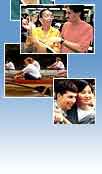![[NEWS AND FACTS BANNER]](/URClipArt/news/titleNewsFactswide.jpg) |
||||||||||||||||

|
||||||||||||||||
Grad Enters the Matrix
There are cool jobs, and then there are really cool jobs. George Borshukov ’95 has a job that falls in the latter category: visual effects technology supervisor for the Matrix movies. He makes the virtual bullets—and bodies—fly onscreen. “We won a technical Oscar in 2000 for the ‘Bullet Time’ fight scene in the first Matrix,” Borshukov, an engineering major while at Rochester, says, referring to the climactic battle where the main character, Neo, played by Keanu Reeves, dodges moving bullets. “That was made up of 120 still pictures.” With an honor like that, it’s no surprise that the same team, Borshukov included, was assigned to work on the second and third installments of the Matrix trilogy as well. New installments of the popular science fiction movie, the second of which, Matrix Reloaded, was one of the most hotly anticipated blockbusters of the summer, meant new challenges for the visual effects team as the movie “upped the stakes” with even more dramatic effects. “What we did previously was backgrounds,” Borshukov says. “But for Matrix Reloaded, we worked on recreating human faces. That was the biggest challenge—to make the faces look real, make the expressions look real.” In order to create accurate expressions, textures, and shadows, Borshukov and his colleagues developed a new system in which digital images of the actors’ expressions were projected onto three-dimensional models of their faces. Two years in the making, the system, Borshukov says, is not fully automated, requiring a great deal of manual work. “But we think it’s come a long way in capturing the actors’ performances,” he says. The system came in handy in the biggest fight scene in Matrix Reloaded, between Neo and dozens of Agent Smiths—a scene those who worked on the film affectionately called the “Burly Brawl.” “We did all the Smith clones. In fact, the last two minutes of the brawl were entirely computer generated,” Borshukov says. The question now is, if visual effects have evolved from recreating backgrounds to recreating human beings, down to their exact expressions, will there soon be no need for real actors at all? “These special effects augment viewers’ experiences, creating scenes that couldn’t possibly be filmed in reality,” Borshukov says. “But without actors, the audience wouldn’t be interested. We are used to looking at the human face—it’s genetically coded into us to recognize a real human. Any deviation from that looks creepy. We have pushed it to another level, but even our stuff looks creepy on occasion.” The final movie in the Matrix trilogy, Matrix Revolutions, is scheduled for a November release. What new heights will special effects reach in the third Matrix movie? Borshukov won’t say. “I’m sworn to secrecy,” he says. “All I can say is that Matrix Revolutions will be very different. We introduced innovative stuff in Matrix Reloaded; in Revolutions, we were using instead of pioneering.” As Neo might say, “Woah.” |
||||||||||||||||
|
||||||||||||||||
| ©Copyright 1999 — 2004 University of Rochester | ||||||||||||||||
